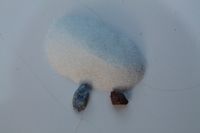Alumina
Alumina is the chemical , or aluminium(III) oxide. It occurs naturally as hexagonal crystals called corundum, the second hardest mineral on Earth.[1] Used without qualification, aluminium oxide usually refers to alumina rather than the other oxides of aluminium.

Characteristics
The hardness of corundum by definition 9 on Mohs' scale and it has a white streak and vitreous lustre.[1]. Corundum has a specific gravity between 3.96[2] and 4.1[1]. The different varieties have refractive indices varying from between 1.759 and 1.767 to between 1.770 and 1.779.[2]
Some corundum, including all rubies, display asterism, which is to say that they reflect light in such a way as to form a six-sided star.[1][2]
Variants
The colour of a corundum crystal depends on impurities.
- Red corundum is known as ruby.
- The red color of Ruby comes from an impurity of considerabbly less than 1% Chromic oxide. The chromium is what permits the ruby to be used for a laser, producing red light. [3]
- Blue corundum is known as sapphire. It gets its colour from iron and titanium impurities[1]
- Colourless (pure) corundum is known as white sapphire.
- Other varieties of corundum crystal are known by colour sapphire. These are pink, yellow, violet and green sapphire[1].
Occurence
On Earth, corundum mainly occurs in metamorphic rock, as well as in alluvial deposits.[1]
Use
- It is used as an abrasive.[1]
- Used in the production of refractory.[1]
- Ruby lasers are based around synthetic ruby crystals, portions of which are doped with chromium.
- Alumina can be used as an aluminium ore.
- Both natural and synthetic corundum is used in jewelry.
- As a catalyst in the Sabatier process.
Open issues
- How common are alumina deposits on Mars?
References
- ↑ 1.0 1.1 1.2 1.3 1.4 1.5 1.6 1.7 1.8 B. Cairncross - Field guide to rocks and minerals of Southern Africa 2004. ISBN 978-1-86872-985-2 pp. 80-82
- ↑ 2.0 2.1 2.2 R. Webster & E.A. Jobbins - Gemmologists' compendium 7th ed. 2001. ISBN 978-0-7198-0291-1 p. 36.
- ↑ McGRAW-HILL ENCYCLOPEDIA OF Science & Technology 8th Edition (c) 1997, vol 15, page 688.







